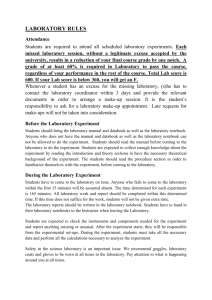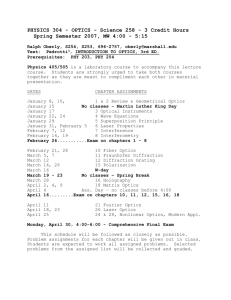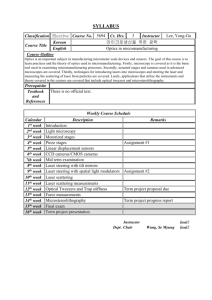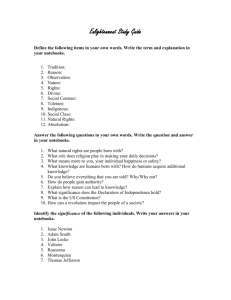Physics 316 Optics and Wave Physics Lab
advertisement
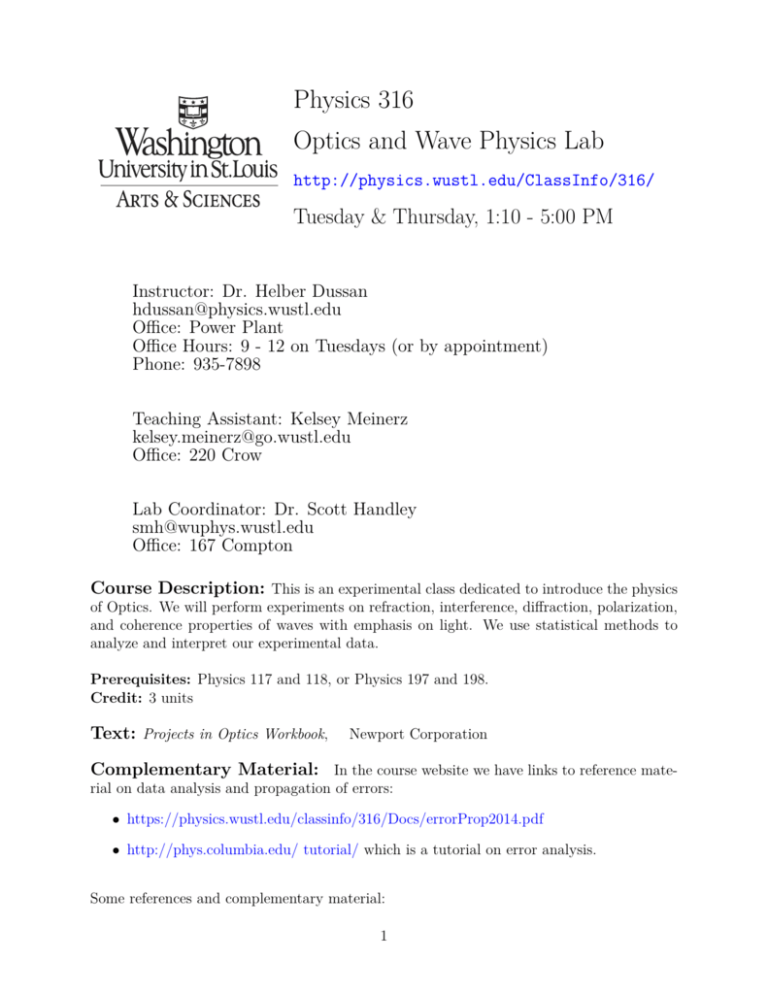
Physics 316 Optics and Wave Physics Lab http://physics.wustl.edu/ClassInfo/316/ Tuesday & Thursday, 1:10 - 5:00 PM Instructor: Dr. Helber Dussan hdussan@physics.wustl.edu Office: Power Plant Office Hours: 9 - 12 on Tuesdays (or by appointment) Phone: 935-7898 Teaching Assistant: Kelsey Meinerz kelsey.meinerz@go.wustl.edu Office: 220 Crow Lab Coordinator: Dr. Scott Handley smh@wuphys.wustl.edu Office: 167 Compton Course Description: This is an experimental class dedicated to introduce the physics of Optics. We will perform experiments on refraction, interference, diffraction, polarization, and coherence properties of waves with emphasis on light. We use statistical methods to analyze and interpret our experimental data. Prerequisites: Physics 117 and 118, or Physics 197 and 198. Credit: 3 units Text: Projects in Optics Workbook, Newport Corporation Complementary Material: In the course website we have links to reference material on data analysis and propagation of errors: • https://physics.wustl.edu/classinfo/316/Docs/errorProp2014.pdf • http://phys.columbia.edu/ tutorial/ which is a tutorial on error analysis. Some references and complementary material: 1 • Optics, E. Hetcht, 4th edition. Addison-Wesley (2001). We have a copy available in the lab. • Physics of Light and Optics, J. Peatross and M. Ware, BYU (2008). See: http://optics.byu.edu/BYUOpticsBook_2008.pdf • PhET Interactive Simulations from University of Colorado Boulder. • Optics Simulations from Florida State University. • Optics Simulations from University of Hawaii at Manoa Course Syllabus: Experiments and chronogram: Dates Jan 13† to Jan 22 Jan 27† to Feb 5 Feb 10† to Feb 12 Feb 17† to Feb 26 March 3† to March 19 (∗ ) March 24† to April 2 April 7 † to April 16 Experiments Laws of geometrical optics: reflection and refraction Thin lenses and lens combinations Expanding laser beams Diffraction of circular apertures and single slit diffraction Michelson interferometer and laser coherence Polarization of light and birefringence of materials The Abbe theory of imaging Project #1 #2 #3 #4 ,#5 #6 , #7 #8, #9 #10 (∗ ) Spring break from the 8th to the 14th of March Class Format: Every Tuesday in which we start a new experiment ( dates marked with † above) we will meet at 1:10 at Crow 206 for a brief introduction of the experiment and following the introduction we will go to the lab, Crow 306. The rest of the times we will directly meet at Crow 306 from 1:10 to 5 PM. In the laboratory, you will work in pairs, but each student should maintain individual lab notes which will provide the basis for preparation of individual written lab reports. Reports need to be submitted for evaluation following completion of each experiment. During the semester you will carry out 7 different experiments. Seven completed and graded experiments are required to obtain a passing grade in the course. Course Objectives 1. Introduction to Optics: To introduce to the main concepts and experimental methods in optical physics. We emphasize the physical principles involved in the experiments 2 and the basic physical phenomena such as refraction, polarization, dispersion, interference, diffraction and image formation. All experiments are quantitative and usually involve observations, measurements, data analysis and interpretation. 2. Introduction to experimentation: To carry out experiments in conjunction with careful data analysis and interpretation. To develop good laboratory practices which, as a rule, are indispensable in any meaningful experimental investigation. These practices include: planning and designing an experiment, adjusting apparatus for optimum performance, keeping adequate records, carefully analyzing and interpreting data; together with the preparation of a lab report including a clear summary and conclusions section. 3. Treatment of experimental data: To analyze the experimental data in more detailed than in the introductory physics courses such as Physics 117 and 118. To apply statistical techniques and analysis of data obtained in the lab. In most cases the objective is to calculate the best values of various measured quantities and to determine their uncertainties. Writing Laboratory Reports Notebooks Use 3 copies of lab notebook type 77-620 (spiral) or Computation Note Book # 77-648 to record your experimental work in ink (except for data points for graphs, schematics or other drawings, which may be in pencil). With three notebooks, you will be able to have one for your current experiment while one is being graded and the third is being prepared for handing in (with your previous experiment). All the steps in your experiment, including rough calculations, derivations, etc. must be recorded neatly in your lab notebooks. Remember to always put the date(s) for the experiment. All graph papers and any other external sheets used must be affixed permanently to the notebook. Graph paper may be downloaded from the optics website. Do not overwrite or tear out pages. Identify mistakes in data recording, etc. by placing a line across the error, e.g. error. While you will work in groups, the data collection, analysis etc. must be shared responsibly. Both members in a group must submit individual lab notebooks. Individual differences in the understanding and interpretation of data must be maintained and reflected in your lab notebooks. This lab will stress the use of hand calculations in the analysis of data and its errors. Therefore, computer based analysis will not be acceptable. However, you are welcome to compare 3 your results with similar analysis using graphical packages done on the computer. In fact, you may find it extremely useful to especially compare least squares analysis with the values obtained via packages like Kaleidagraph, Excel, etc. Follow the attached guidelines for the presentation of your experiments and results in your notebooks. Date Group 01-22-2015 3 .. .. . . Number - Experiment Name 2- Thin lenses and lens combination .. .. . . Page(s) Comments 2 -11 completed .. .. . . First Page of Lab Notebook Objective: In your own words describe briefly the objective of this experiment. Following this you should make an attempt to intuitively analyze the experiment till its conclusion. This section can be treated as a “thinking aloud" of the experiment as it would be performed if it were a gedanken or thought experiment. In other words, your intuitive understanding of how the quantity will be measured should be clearly visible in any description you put down in this section. This section should be brief and in most cases 2 pages should be sufficient. Use only the right hand pages for this section. To help you in your thought process, you may use the left hand side to make a bulleted summary of some of the key steps played out in your mind to carry out the experiment. At the end of this report, you will end by comparing the actual steps you took to some of the steps you thought you would. Experimental procedure and tabulated list of apparatus This section must also be kept to the right hand pages of your notebooks. Detail the various steps that you feel were necessary to successfully carry out the experiment, with a brief explanation of why the step was required. For example, you may find that the leveling of some components was essential and required additional tools, like a liquid level. The steps that you record here need not include the important ones outlined in the experiment handouts. However, if you find that you could or did use an alternate approach, you must record it. To tabulate the list of items, follow the systematic approach shown in the table below: Item Name Serial # or Other ID # Quantity He-Ne laser .. . R31005 .. . 1 .. . 4 Comments Used a special stand to help alignment of the laser .. . You do not need to include basic tools like screwdrivers, etc. However, if you find problems or made some modifications to existing tools please record it. It will help us in improving the quality of the tools that we provide. Use as necessary additional pages for the table. Schematic sketch of the experimental set-up (Can be done in pencil) Using the left hand page, neatly outline the schematic of your experiment. If possible use the notations in the handouts to mark the key dimensions on your drawing. Use similar notations in the collections and analysis of your data to follow. Ensure that the schematic is tidy by using rulers, etc. to make your drawings. A computer should not be used to create the schematics. Measurements, Calculations, Analysis and Results Record neatly your data, formulas, derivations, etc. As far as possible use tabulated data and use the right hand pages. Clearly define the sources of error in your measurement and estimate them. Where appropriate, the mean values, their standard errors, best estimates using statistical procedures, any discrepancies and/or inconsistencies must be evaluated. (Error analysis is discussed in the handout, which is also posted on the class website). All measurements should be repeated at least 4 times (> 2 times by you, and > 2 times by your partner). This will aid in estimating errors to the best precision. For repeated measurements, report the result as mean plus-minus the standard error of the mean (described in the error analysis handout). For calculations that involve multiple such mean values for different variables, the error to the final result will be calculated using the error propagation method. If the values in each measurement differ by more than the associated measurement error, a standard deviation calculation for the repeated measurement results should be performed and used for the error of the final result. The method to obtain the correct number of significant digits for both the final result and its error is also described in the error analysis handout. When your final experimental results disagree with the expected values by more than the propagated error, explain and (even better) quantify possible sources of systematic errors that can contribute to this. All graphs and plots must be on the left side. Use graph paper to plot your data and then affix the paper to the left side. Use clearly labeled axis and titles for the graphs. The source and magnitude of the error bars used must be clearly mentioned. Use the standard error to 5 the mean for error bars of repeated measurements. You can also use least squares fitting of the data points as described in the error analysis handout. All rough calculations etc. should also be restricted to the left side, with a clear header indicating so. Discussion and Conclusion End the report with a brief summary of your experiment and its results. A good format to follow for this section is that of a widely circulated journal like one published by the AIP, for example the Applied Physics Letters. Also add a discussion of your understanding of the experiment. Ideally, you would like to compare the experiment to your original thought and put down the various aspects of it, especially the physics related ones, that you found to be interesting and unanticipated. Add a brief comment or two about any serious problems you had (if any) in performing the experiments. Note, you can also do this in the comments section at the beginning of your lab notebooks. Grade: Lab report 100 points. • 20 pts: Understanding of the relevant physics: Write up your understanding of the physics principles of each experiment in the Aim/Objective section of the lab report. Use these principles throughout the experiment for data analysis, interpretation, and problem solving. • 20 pts: Laboratory procedures and quality of measurements: Keep your notebook in the form of a journal, with an entry for each day you are in the lab, even if not much happened. You should write your notes assuming that someone is going to repeat your work with the same apparatus. Be sure to note everything that could have affected your results or caused problems. • 20 pts: Presentation treatment and interpretation: Include clear presentation of tables, units and error estimates on all data. If you are calculating a quantity or converting measured values to something else, show an example of the full calculation once. • 10 pts: Error analyses: Report all your measurements with uncertainties and carry the corresponding propagation of errors. • 10 pts: Conciseness and clarity of the laboratory report: Do not write every detail of everything, report only the relevant ones to the experiment that happens each day, using simple and clear language. 6 • 20 pts: Provide answers to questions in the report of each experiment • Lab reports are due ONE WEEK after completion of the experiment (unless otherwise specified in class). • -5 pts: Each day the lab report is overdue. • -10pts: If equipment is not returned to the original location and stored properly at the end of each experiment. Meaningful originality and extra work will be taken into account, as will also constructive ideas and contributions beyond the requirements. Suggestions for improving the course notes are welcome. 7 Course Policies: • Lab Rules 1. No smoking, food or drinks in the laboratory. 2. The laboratory equipment is new and sensitive, please treat it with care. 3. Handle the optical equipment with gloves, in particular, optical surfaces like lenses and mirrors. 4. Return all optical elements and equipment to proper storage locations (Points will be deducted if equipment is not returned to storage location and stored properly). For example, if an optical element is removed from a package, it must be returned to that package. • Laboratory Safety – NEVER LOOK DIRECTLY INTO A LASER BEAM OR INTO ITS STRONG REFLECTION Ordinary low-power, classroom lasers produce optical irradiance which can be about 1000 times greater than a safe level if viewed directly or in specular reflection. A “safe" level recommended by the American Conference of Government Industrial Hygienists (1968) for daylight illumination is 5 x 10−5 watts/cm2. A 1-milliwatt laser with a beam diameter of 1.5 mm at the aperture produces about 6 x 10 −2 watts/cm2 at the aperture, a value about 1000 times greater than this "safe" value. Even 40 feet away such a laser may produce about 6 x 10−4 watts/cm2 in the direct beam, a value 10 times greater than the proposed safe level. Therefore, use great caution with lasers. It is almost always unsafe to view an unfiltered or undiverged laser beam, either directly or in specular reflection. Otherwise, permanent damage to the eye may result. – Remove reflective objects when operating laser for your and your partner’s safety. – High-Intensity Lamps: Take adequate precautions to avoid unnecessary exposure of eyes to high-intensity lamps. – Power Supplies: Some experiments may require the use of high voltage power supplies. Ensure that proper precautions are taken in the use of cables and connectors for these supplies. Never open the covers to make modifications or correct problems. Please report any problems with the supplies to the TA or instructor. 8



